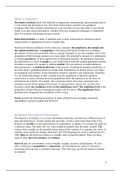Summary
Midterm book summary for statistics
- Course
- Institution
- Book
Eight pages with consistent and easily summarised statistics covering chapter 1 to 6. Perfect for midterms, quizzes and more! Perfect document to learn the main parts of statistics for the first 6 chapters in the course.
[Show more]



